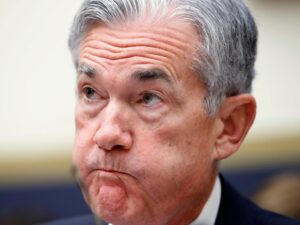Fed Rate Cuts: Analyzing the Market’s Reaction and Future Implications
In an unexpected move, the Federal Reserve announced a cut in its benchmark interest rate to a range of 4.25% to 4.5%. This decision marks a significant reduction of 100 basis points since mid-September. Typically, rate cuts are celebrated by investors as they tend to lower borrowing costs, incentivizing spending, investment, and hiring. Moreover, they usually signal that inflation is under control, making risk assets, such as stocks, more appealing as Treasury yields decline.
However, this latest announcement took the market by surprise and sent stocks tumbling. The central bank forecasted only two cuts next year, down from the previously anticipated four, leading to a nearly 3% decline in the S&P 500 and Dow Jones, with the Nasdaq 100 dipping nearly 4%. The volatility was palpable, with the VIX index—known as the stock market’s fear gauge—surging by 74%, marking its second-largest one-day spike in history.
Overreactions or Sound Strategy?
While some analysts believe that the market’s reaction to the Fed’s hints of slower rate cuts was overblown, others point out that it reflects deeper concerns among investors. Jennifer Schleif, an analyst, noted that the market seemed to overlook comments from Chair Jerome Powell that indicated a healthy economy. "The slower pace of Fed cuts is for a good reason," she explained, emphasizing the importance of maintaining a robust economic backdrop for stocks and earnings.
Citi’s economists suggested that the Fed’s current hawkish stance may soon pivot dovish should the labor market show signs of weakness. With only 50 basis points of interest-rate reductions priced into the market until mid-2026, expect significant adjustments as data unfolds. According to economists, the continued softening of the labor market will likely compel the Fed to cut rates more aggressively than the market currently anticipates.
Long-Term Perspectives and Opportunities
Despite the recent sell-off, some experts urge investors to view this moment as a "buy the dip" opportunity, especially as the year-end "Santa Claus rally" approaches. Dan Ives, a leading analyst, encourages investors to stay focused on long-term trends, particularly the development of artificial intelligence and a potentially favorable regulatory environment for mergers and acquisitions.
“Markets are psychologically poised to overreact to Fed policy changes,” Ives remarked. He encourages investors to adopt a more measured approach, suggesting that robust economic growth and earnings will ultimately steer the market higher, even amid looming inflation concerns.
Furthermore, while recent market behavior appears pessimistic, historical patterns demonstrate that corrections can pave the way for upward momentum. A cautious but strategically optimistic approach is warranted, as analysts anticipate that once initial jostling subsides, growth catalysts could reassert themselves.
Looking Ahead: Navigating Uncertainty
The Fed’s latest meeting has reignited clouds of uncertainty around monetary policy for the upcoming year. With inflation showing signs of increasing due to potential trade tariffs and labor market pressures easing, two more rate reductions in 2025 seem plausible.
Nevertheless, as the market grapples with these shifting dynamics, it remains crucial for investors to maintain a focus on tangible growth sectors. Historical trends suggest that substantial shifts in monetary policy often create fertile ground for opportunities—providing a compelling case for vigilance and strategic investment.
In summary, the Fed’s rate cuts may pose short-term challenges, but they also come with potential areas for growth. A balanced view that considers both immediate market reactions and long-term economic conditions is essential for navigating the complexities of the investment landscape. Staying informed and agile will empower investors to not just weather the turbulence but thrive in the evolving financial environment.
For those seeking to stay ahead in this ever-changing financial landscape, leveraging insights from a community like Extreme Investor Network can provide the strategic edge needed to capitalize on market movements. Join us as we break down the complexities of finance, helping you navigate the path toward sustained investment success.

